by Lance Hill | Aug 2, 2019 | Mirliton

Renee Lapeyrolerie, proud grower in Treme neighbor of New Orleans
As a young girl in St. John Parish, Louisiana, Renee Lapeyrolerie lived in a community in which mirlitons were a common site in back yards. When she moved to New Orleans to attend Loyola University, she soon began to yearn for the lush growth of the vine. 20 years ago she bought a home in the centuries-old African American neighborhood of Treme (pronounced, Tra-May), a famous community of free people of color, many of them migrants from Haiti, and including a maternal ancestor who bought property in 1795. Haitians brought mirlitons with them from their new nation, an integral part of Haitian cuisine.
Parts of the Treme flooded during hurricane Katrina, but only a few feet. The community was part of the slim alluvial ridge along the Mississippi river and was home to mirliton gardeners for decades.
About five years ago Lapeyrolerie (pronounced Lap-a-rol-er-y) purchased a mirliton sprout from a garden center and planted it in her back yard. The vine soon spread about 20 feet along her fence and began to charge up her neighbor’s tree. Its origins as a variety are uncertain, but it is definitely part of the Louisiana landrace because it fits the phenotype (large but uniquely without furrows) and it has proven it can flourish in our climate. In the early years she had some problems with the vine flowering but not fruiting. This was not unusual for New Orleans post-Katrina because the flooding and re-roofing destroyed the habitat for bees (many hives were in attics that were disturbed by roofing). She is considering using a synthetic bee pheromone to attract bees this fall, though she can hand pollinate using instructions on our photo site.
In recent years, her five year old plant produced a good fall crop and she even got a modest spring crop in 2019. For advice on the culture of the plant, Renee had only go to her Aunt Helen and neighbors back in St. John Parish. Renee hopes to inspire fellow Treme residents to take up the mirliton and renew a tradition that is two centuries old and has donated several sprouts and plants to Mirliton.Org.
We have named the variety the “Lapeyrolerie Mirliton Variety” in honor of Renee. 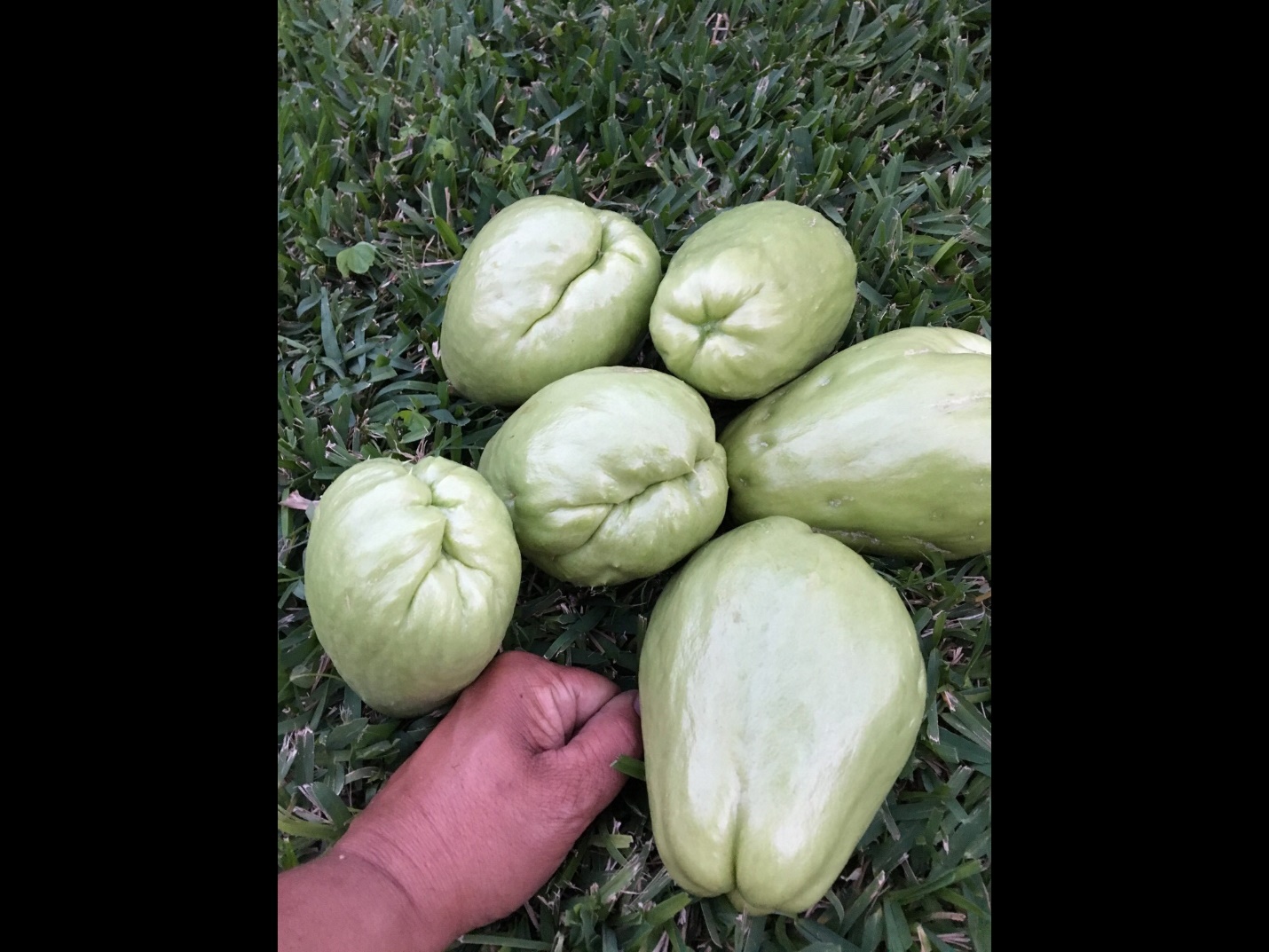 Lapeyrolerie Mirlitons
Lapeyrolerie Mirlitons
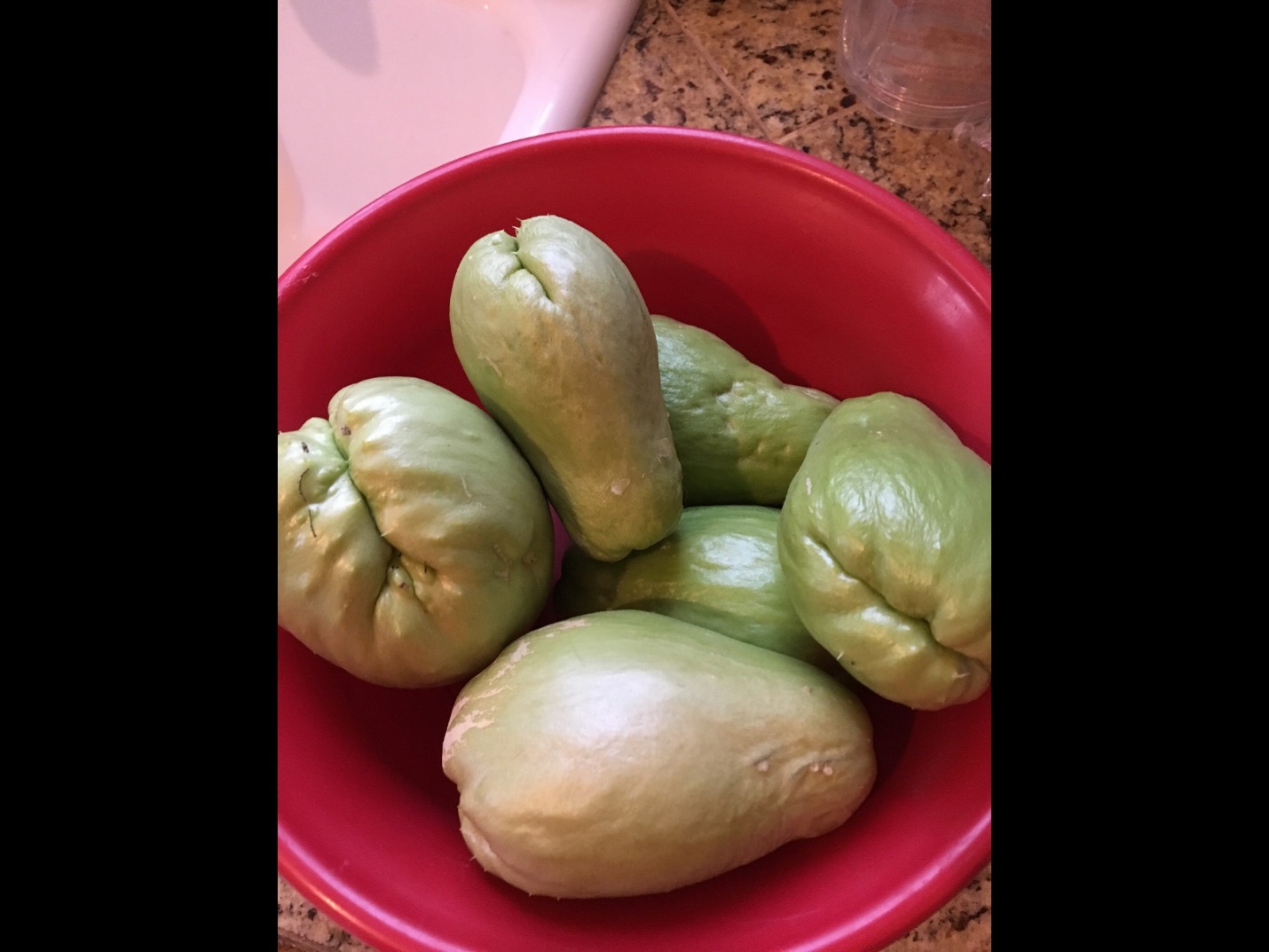
Lapeyrolerie Mirlitons
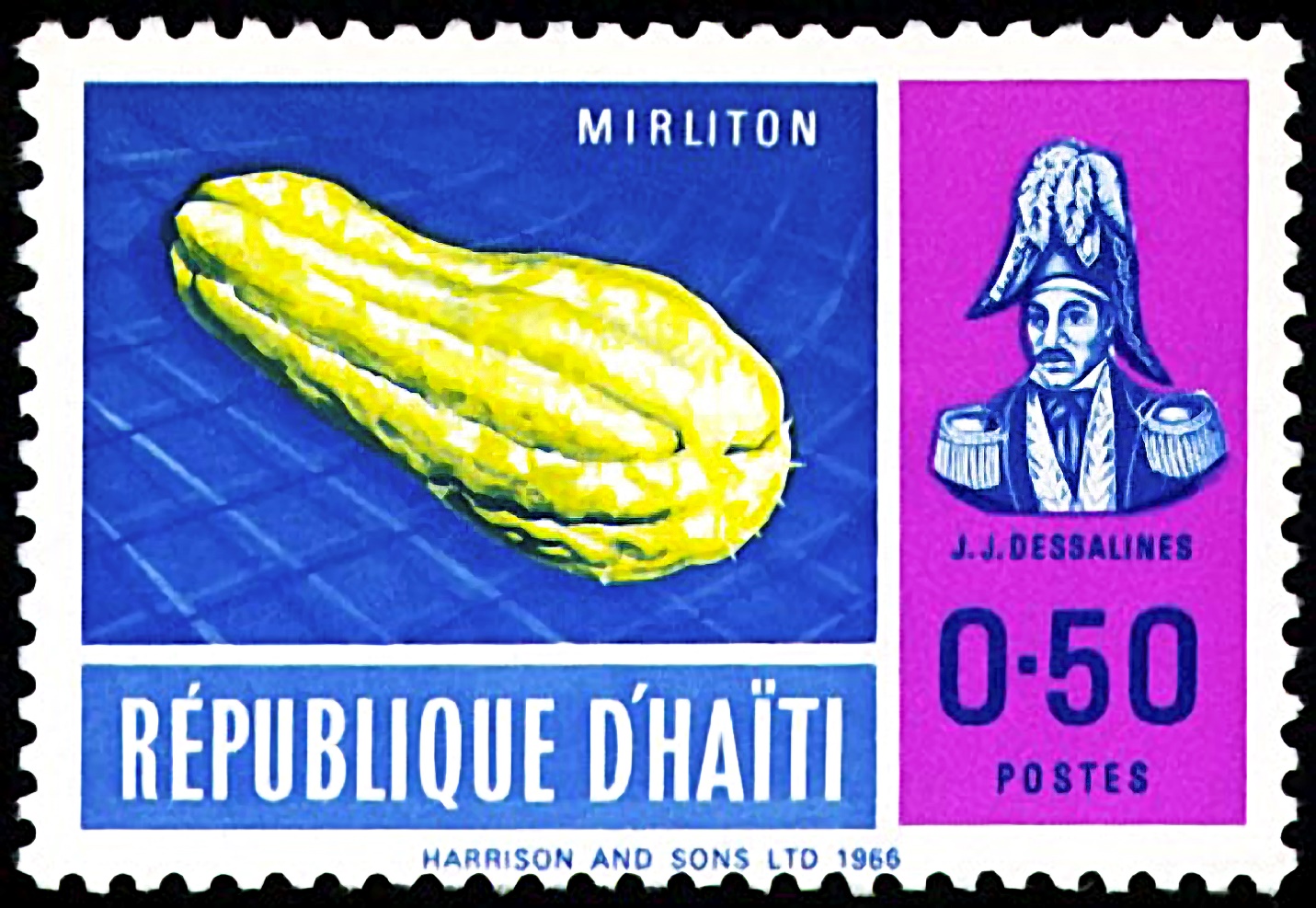
1 Haitian postage stamp, circa 1966

Renee Lapeyrolerie, proud grower in Treme neighbor of New Orleans
As a young girl in St. John Parish, Louisiana, Renee Lapeyrolerie lived in a community in which mirlitons were a common site in back yards. When she moved to New Orleans to attend Loyola University, she soon began to yearn for the lush growth of the vine. 20 years ago she bought a home in the centuries-old African American neighborhood of Treme (pronounced, Tra-May), a famous community of free people of color, many of them migrants from Haiti, and including a maternal ancestor who bought property in 1795. Haitians brought mirlitons with them from their new nation, an integral part of Haitian cuisine.
Parts of the Treme flooded during hurricane Katrina, but only a few feet. The community was part of the slim alluvial ridge along the Mississippi river and was home to mirliton gardeners for decades.
About five years ago Lapeyrolerie (pronounced Lap-a-rol-er-y) purchased a mirliton sprout from a garden center and planted it in her back yard. The vine soon spread about 20 feet along her fence and began to charge up her neighbor’s tree. Its origins as a variety are uncertain, but it is definitely part of the Louisiana landrace because it fits the phenotype (large but uniquely without furrows) and it has proven it can flourish in our climate. In the early years she had some problems with the vine flowering but not fruiting. This was not unusual for New Orleans post-Katrina because the flooding and re-roofing destroyed the habitat for bees (many hives were in attics that were disturbed by roofing). She is considering using a synthetic bee pheromone to attract bees this fall, though she can hand pollinate using instructions on our photo site.
In recent years, her five year old plant produced a good fall crop and she even got a modest spring crop in 2019. For advice on the culture of the plant, Renee had only go to her Aunt Helen and neighbors back in St. John Parish. Renee hopes to inspire fellow Treme residents to take up the mirliton and renew a tradition that is two centuries old and has donated several sprouts and plants to Mirliton.Org.
We have named the variety the “Lapeyrolerie Mirliton Variety” in honor of Renee. 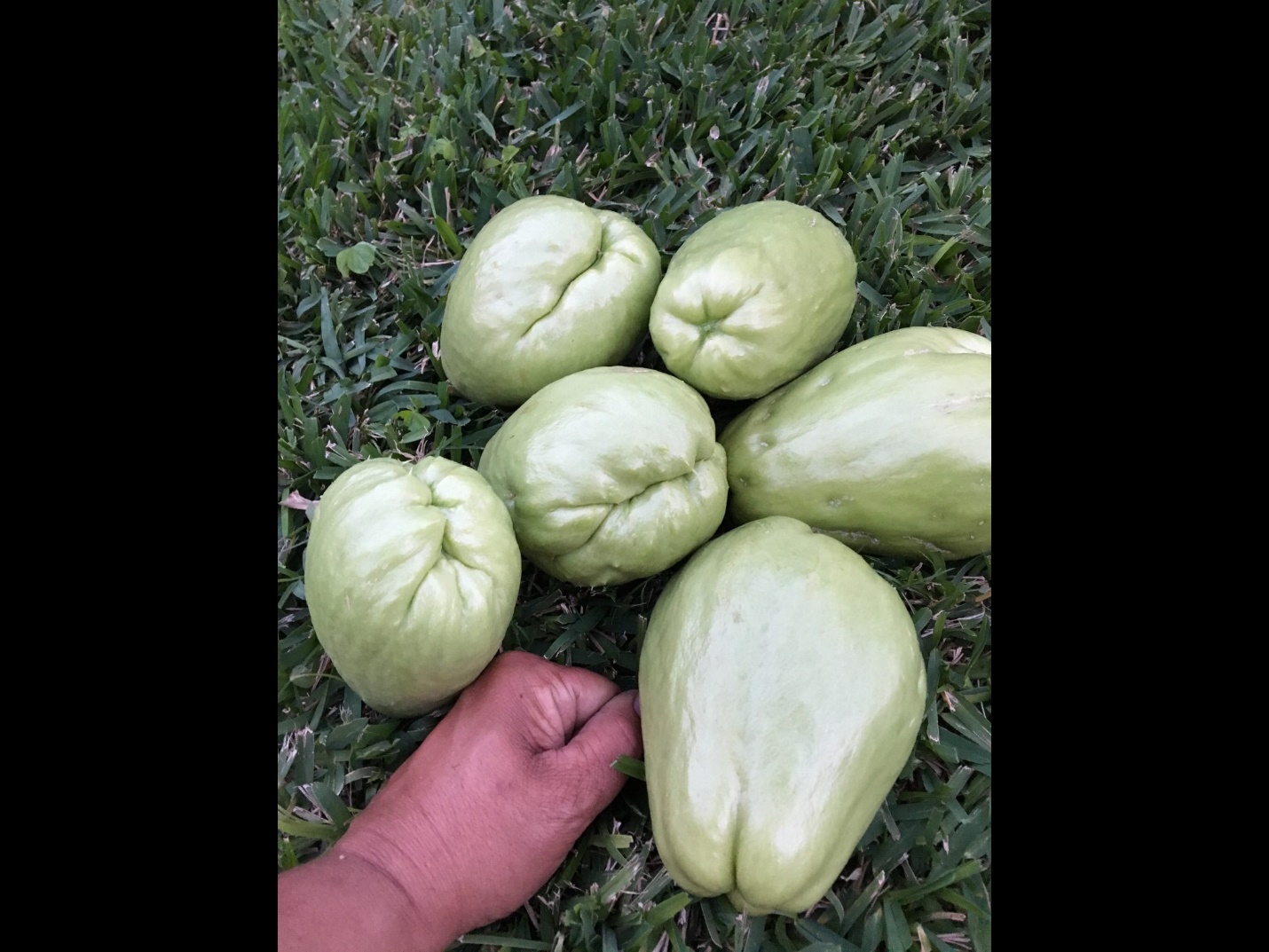 Lapeyrolerie Mirlitons
Lapeyrolerie Mirlitons
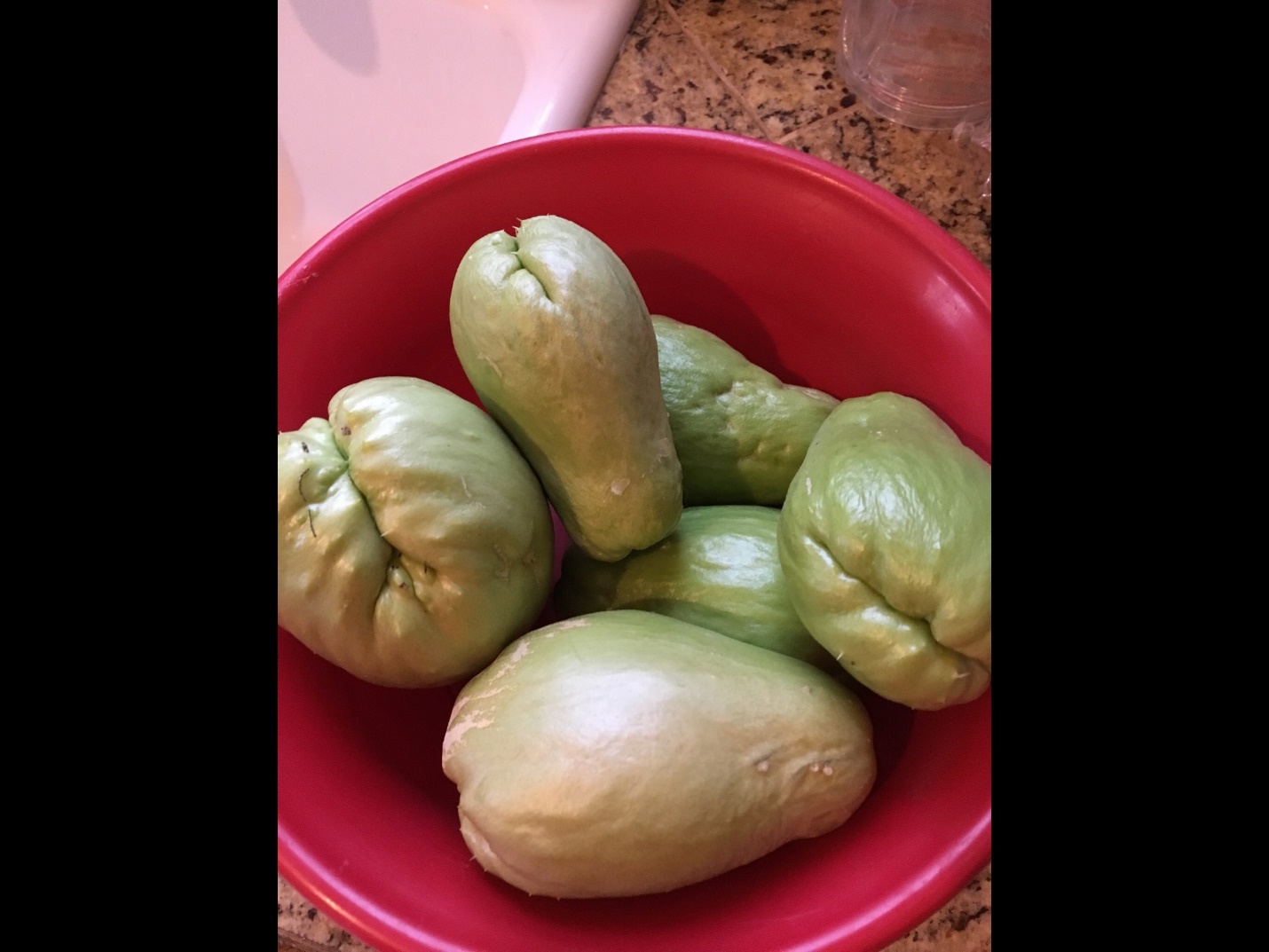
Lapeyrolerie Mirlitons
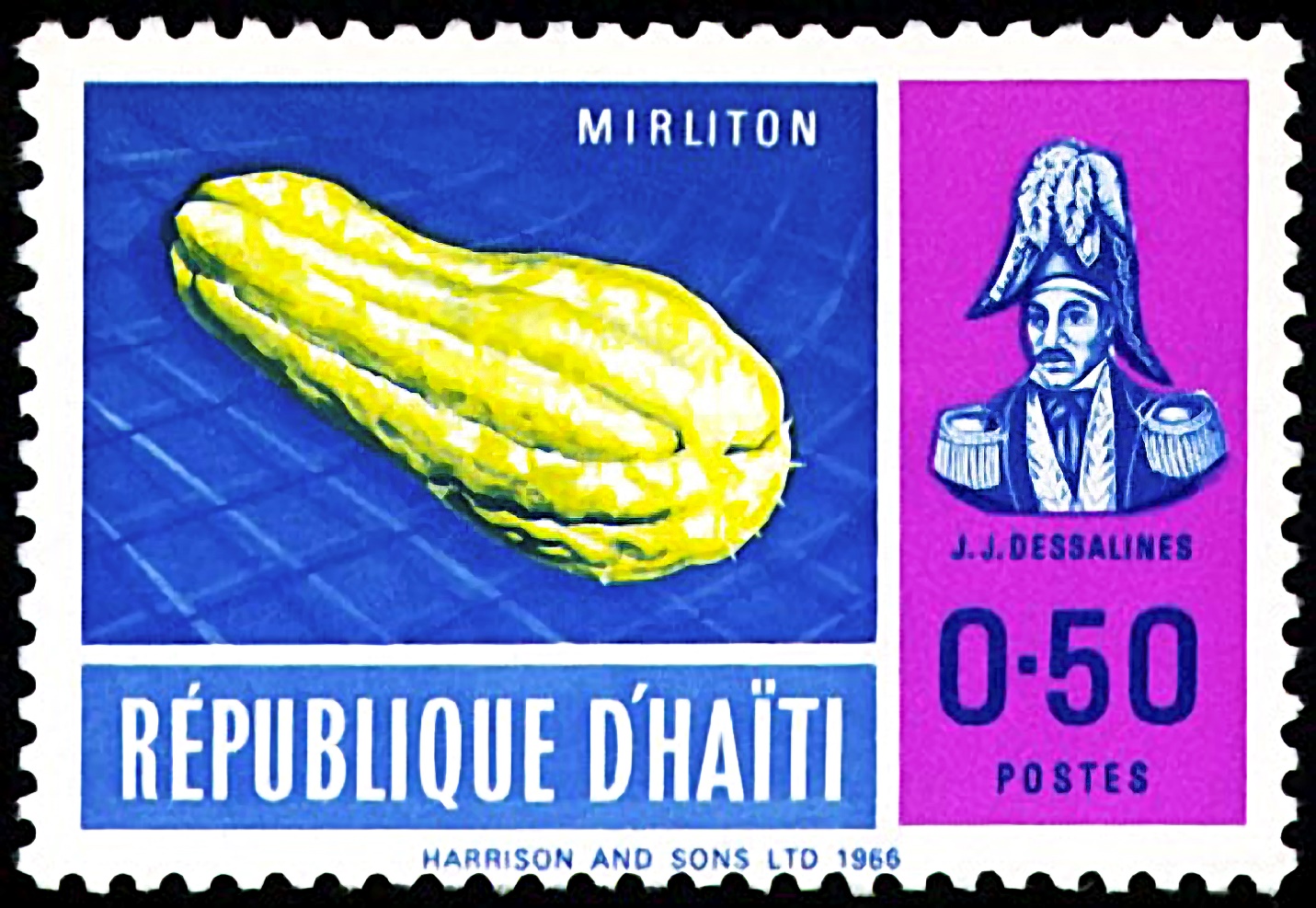
1 Haitian postage stamp, circa 1966
by Lance Hill | May 4, 2019 | Mirliton
Jason Fricke Saves An Endangered Heirloom Mirliton Variety in Texas
By Lance Hill
I had a long friendship with Jason Fricke of Pearland, Texas, a city within the Houston metropolitan area, in starting his project to be the first person to grow Louisiana heirloom mirlitons in Texas. Our email correspondence dates back nine years. Fricke was raised in New Orleans and moved to Houston, where he longed to expand mirliton growing to Texas. And there was a large demand for Mirlitons in Texas, do to the large migration of mirliton-loving Louisianans that occurred after the 2005 Hurricane Katrina.
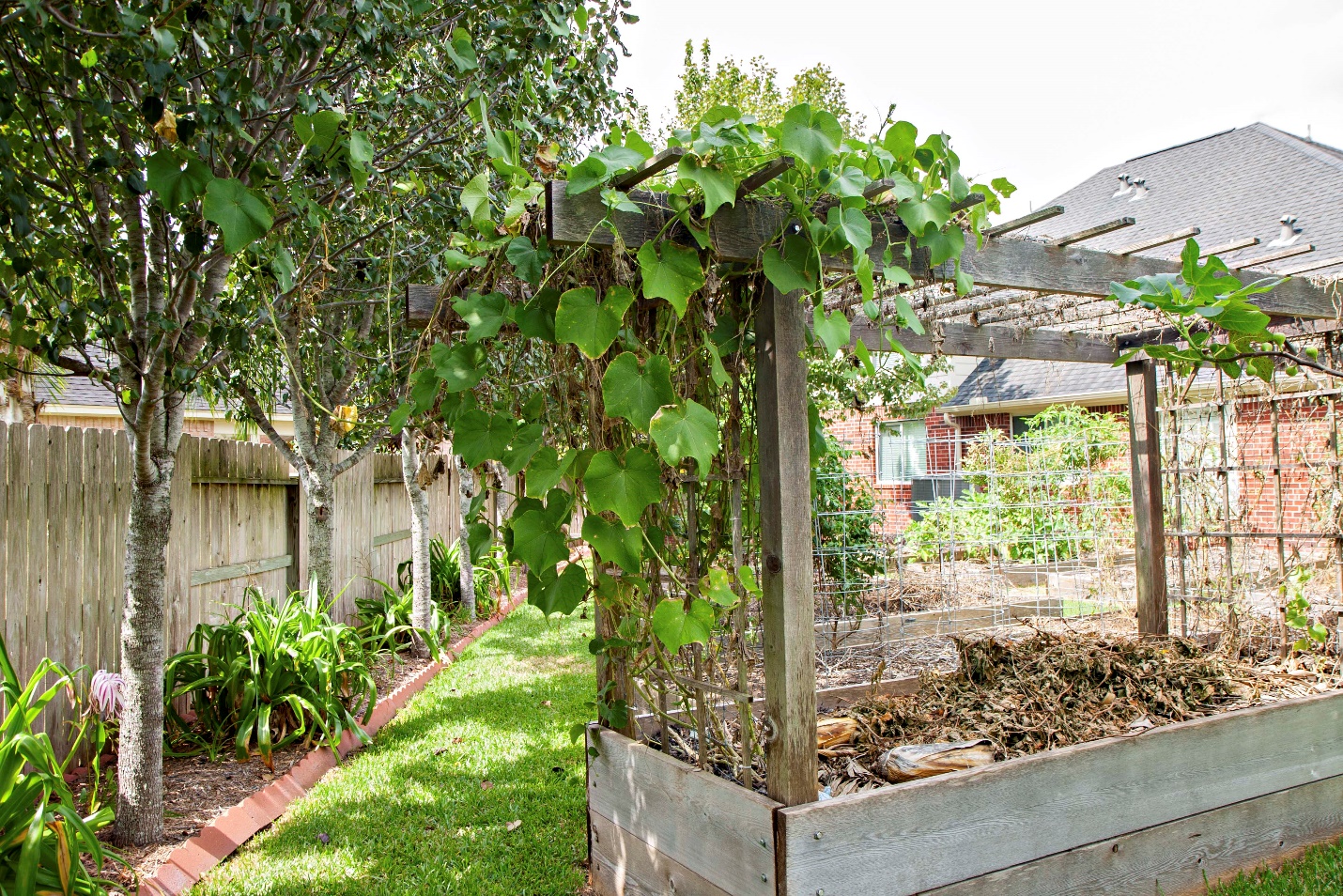
Figure 1 Jason Fricke’s mirliton site in Pearland, Texas in 2014
Fricke is a persistent and thorough gardener. He read all Mirliton.Org research and listened to our recommendations. We started out encouraging him to grow mirlitons that matched his home’s climate and altitude. South Texas is similar to hot and humid coastal Louisiana; Houston is at 43 feet altitude, nearly sea-level like coastal Louisiana, and has 53 inches of annual rainfall, also comparable to Louisiana.
The first step was to provide a Louisiana heirloom mirlitons to Fricke. The most certain way to determine if a mirliton is indeed an heirloom variety is to ask the question: was the variety locally-grown or was it purchased from a store and of unknown origin? We started by giving Fricke the “James Boutte” variety from New Iberia, Louisiana that had been grown for decades by James Boutte and his son Kevin. After a few site visits to the Boutte garden in New Iberia, the elder Boutte donated several sprouts for us to place with new growers. (see the massive Boutte vine here)
We gave some of these sprouts to Fricke and after a few years of false-starts, finally in November 2014 Fricke had success, proving that mirlitons could be grown in Texas with the right variety and proper techniques. Fricke harvested 44 mirlitons of which twenty were good seed-size and were given to fellow Texans who wanted to grow them. A few were huge and reserved to expand Fricke’s garden. The smaller ones were used for Thanksgiving dinner, as is an old Louisiana tradition. The harvest was produced by four vines located in three planting spots. The diameter of the stems at the ground were 4.5”, 4.5”, 5” and 6”.
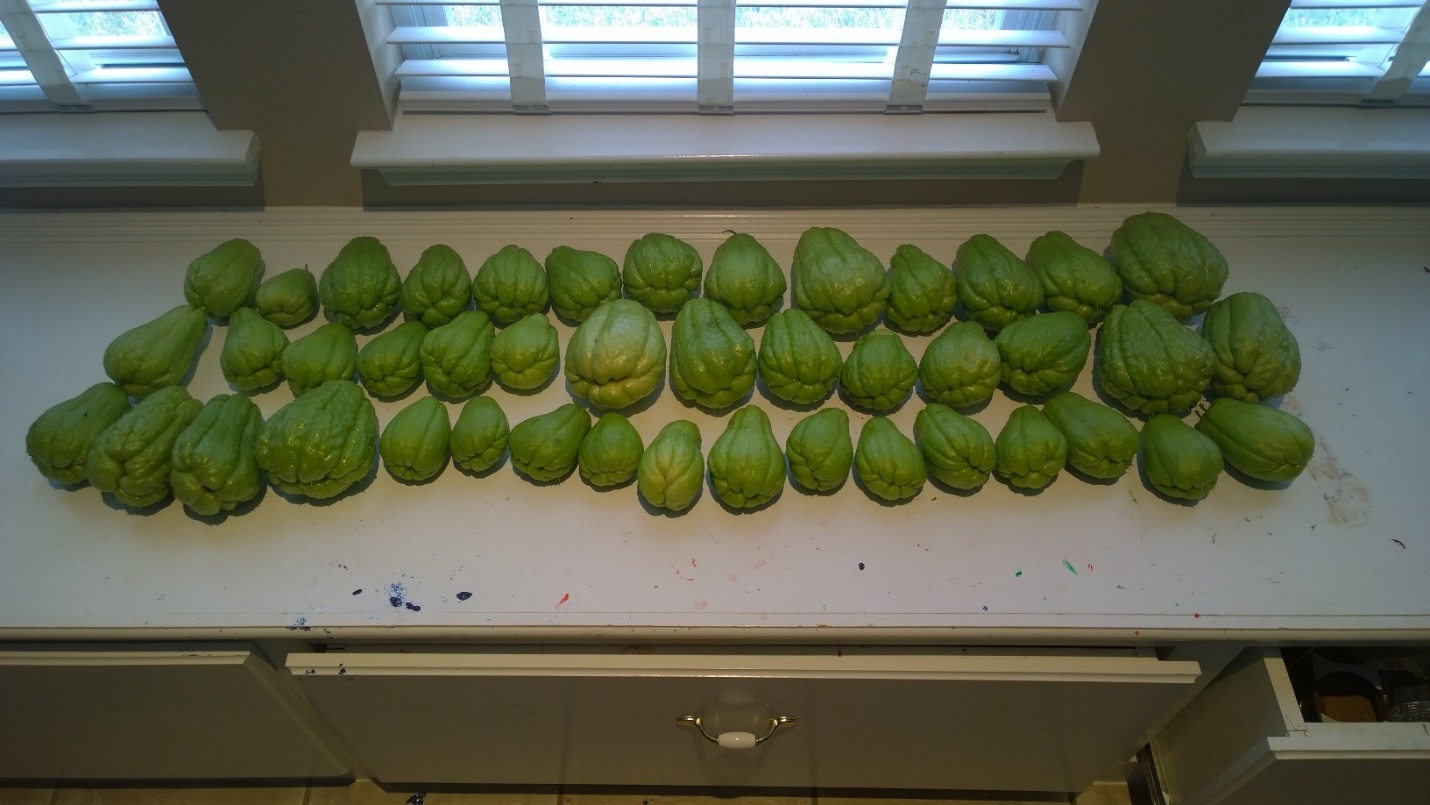
Figure 2 Fall harvest for Houston, Texas, November 2014, James Boutte heirloom mirliton variety
Originally, Fricke built a raised bed, 12″ deep and 4’x 20′ in dimensions. The problem was that the beds were not deep enough. Mirlitons don’t tolerate wide fluctuations in soil moisture content. The damping and drying-out stresses the plant and contributes to plant diseases like anthracnose. It is important that the raised bed sits on ground soil that is also well-drained. If the ground soil is soaked, the bed cannot drain properly and the raised-bed soil will also be water-logged also (bed drainage can easily be ensured by adding a perforated drain pipe to the bed, see link),
Fricke solved that problem by deepening the bed to 24”, evening out soil moisture fluctuations. He worked in sphagnum moss and used a good grade of potting soil. He placed the bed on the highest 25% of the yard, sitting on the ground soil which was a loamy clay. There was about a half-inch gap between the cedar boards and the ground soil so the whole bed was slightly raised above ground level. The bed was covered by a horizontal goat-fence trellis about 5′ above the bed.
When Fricke began growing mirlitons in 2011 he also planted cucuzza in the same bed. We advised him against growing any other cucurbit is the same garden. Cucuzza, cucumbers and other garden cucurbits are hybridized for resistance to plant fungi; that means that they can host the anthracnose fungi and while the fungus won’t kill the hybridized plants, the plants act as a sporelator spreading spores that can infect the mirliton. I have observed that successful mirliton growers grow only mirlitons and no other cucurbits to avoid this problem. Fricke removed the cucuzza and cleared the way for a healthier environment.
Fricke also began to increase his odds of success by planting multiple sprouts. It is very hard to get one or two mirlitons to grow in the first year. Multiple plantings can always be thinned out later.
In 2013, Fricke obtained 15 sprouts from James Boutte’s son, son Kevin who had taken over the vine. He learned a great deal by experimenting with different planting methods. Interestingly, out of 15 vines that Fricke started, only six made it through the summer heat of Houston. Of those original 15 vines, the three that thrived the most were planted directly in the raised beds the previous November. So starting the plants six months before in the fall was more effective than direct planting in the spring. This makes sense since a fall planting gave mirlitons several months to develop a root structure before the summer heat and rains.
Fricke had filled the beds with “Living Earth Rose Soil”, a high-quality container soil available throughout Texas, which is basically a very porous sandy soil, high in compost and organic matter. He then top-dressed the beds with his own compost and mulched a few times per year. He worked in a lot of sphagnum peat moss so that the top half of the bed was 1/3 peat. For fertilizer, Fricke added a small amount of Microlife 8-4-6 in April and some liquid 10-8-8 foliar feeding in June.
He also adjusted the watering schedule and used a drip system to try to keep the moisture levels more even. The beds drained quickly due to the sandiness, even during heavy rains. The peat moss also made a very apparent difference in moisture retention.
Now, several years into his successful mirliton project, Fricke is eager to provide “James Boutte” mirliton variety to other Texas growers.
It was none too soon. James Boutte, the scion of the variety that bore his name, died in 2015 at the age of 97. His family lost the land to the bank, so the entire mirliton farm died off.
But thanks to Jason Fricke’s determined and creative work, the “James Boutte” variety survives in its new home in Texas. 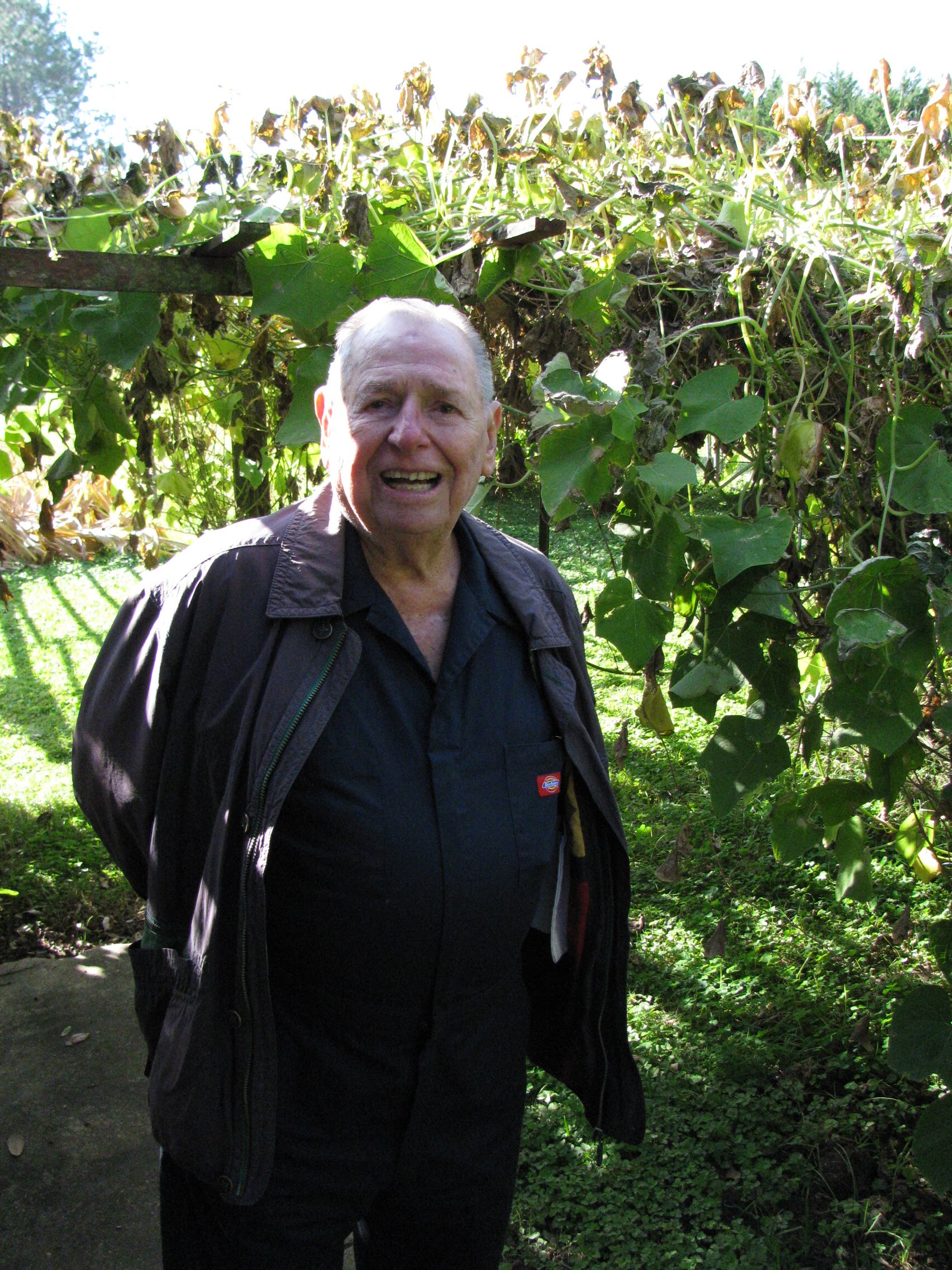
Figure James Boutte. New Iberia, Louisiana, 2010. Boutte died in 2017.
by Lance Hill | Nov 10, 2018 | Mirliton
The Mirliton Man of Mobile Alabama
This blog entry is by David Hubbell. It tells the story of his efforts to grow mirlitons in the Gulf coast South. We welcome other growers to send in their stories, growing methods, and photos of the varieties they are growing. You can reach him by sending me an email at Lance@mirliton.org)
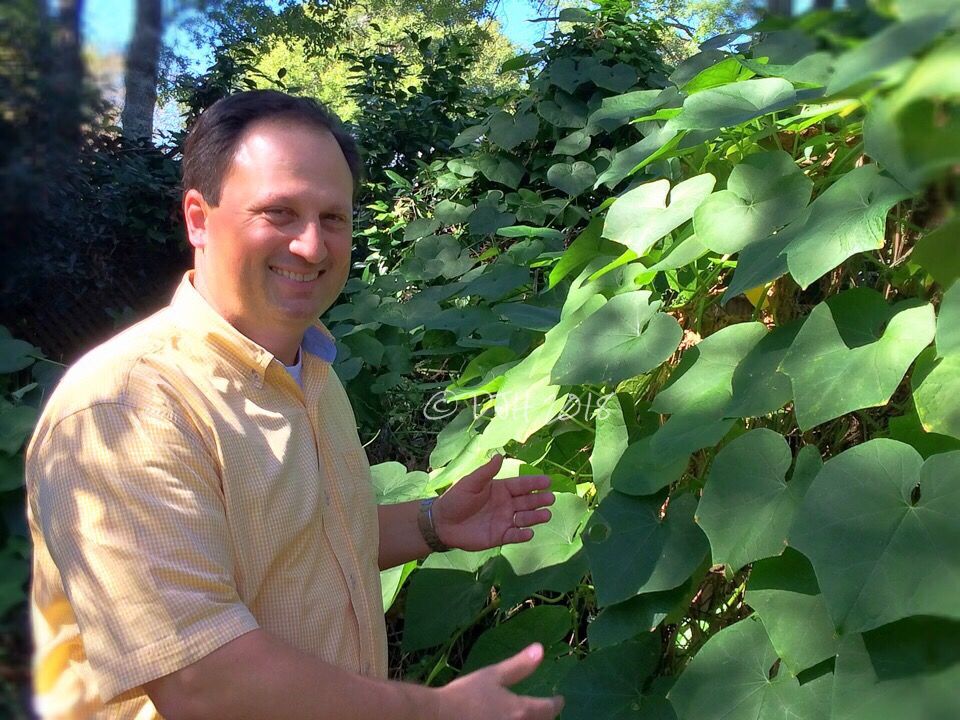 David Hubbell with his Boudreaux-Robert heirloom mirliton variety.
David Hubbell with his Boudreaux-Robert heirloom mirliton variety.
My Mirliton Story by David J. Hubbell
Part I – Initial Attempts
Since my early teens I have been fascinated with my Louisiana ancestry. I learned early on that I am descended from the Germans and French that arrived in the early 1700s, as well as the Acadians that settled in St James Parish in 1765. Despite this long pedigree, I have never actually lived in Louisiana for any appreciable amount of time. After marrying and settling down in Mobile, it became one of my goals to create a Louisiana garden at my home in south Alabama. One of the items I started trying to grow back in 2006/2007 was mirliton (AKA chayote squash or vegetable pears).
I scoured the internet for where to acquire the seeds and how to grow it. Well, I learned in short order from the LSU AgCenter site that one doesn’t extract the seed, but simply set the fruit or seed mirliton in a cool, dark place wrapped in a paper bag and within a few weeks, you should get roots and a vine will start. Now the question was “where to get it?” According to some folks who grew it in California, I simply needed to find a grocery store that sold them and plant those. So now I had a mission. Where to find one? Well, I really had to go no further than my Mom (don’t they always have the answers?) She mentioned that she had seen them at several of the local grocery stores, in particular a large one stop megastore. Now I should add at this point that as a kid growing up in Texas we rarely ate these. Similarly, on visits to Metairie, Louisiana at Christmas, I never was interested in trying mirliton. Therefore, I had a twofold challenge: 1) figuring out how to grow them and 2) how to eventually cook them. So off I went and lo and behold, I found them for about $1.29 apiece. Well, even though I rarely had seen them, my memories from my childhood and the images from my research didn’t quite match the ones I had found. Most of what I saw looked pretty close, but it was more of a “snubbed nose” version. The sticker on them indicated they were a product from either Mexico or Costa Rica. I found 3 that closely resembled the images in my head, purchased them, and then brought them home. I then promptly followed the directions from the good folks at LSU and within a few weeks’ time, I was delighted to see that two of the seed mirliton had roots and vines were emerging. This was around December and by late February; I planted the two into the ground next to a very ornate trellis I bought for them to grow up. I had some conversations with my Pepere (grandfather in Louisiana French) who had grown them a while back and he mentioned to be careful where you plant them. I believe he mentioned having them too close to a tall oak and having to use a ladder to get the fruit. As a result, I tied a rope between my trellis and a large oak in my back yard, which was around 30 feet away. Well the first year, the vines emerged and started to grow. They grew all spring and summer and while they didn’t get quite as long as the information from LSU indicated, I figured it was due to them being young (FYI these vines will come back year after year if protected from the freezing weather). Well in addition, I finally started to see some male and female flowers on the same vine; however, it was now early September and I had read that one should be harvesting them from late September until late November (or until freezing weather hits). Eventually some small fruit did appear, but they never seemed to get much larger than a raisin and by then, freezing weather arrived in south Alabama. So, my first attempt turned out not to be a fruitful one.
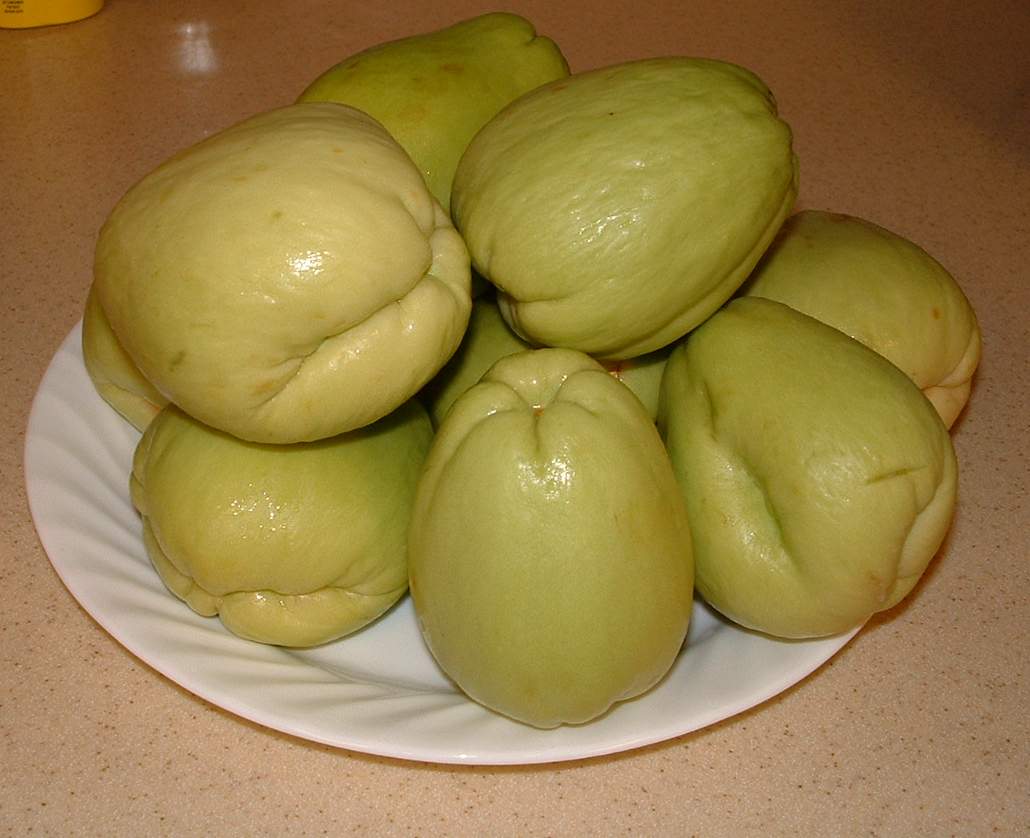
Store bought Mirliton
Despite not producing any fruit, I had actually gained quite a bit of knowledge on how to start these plants and what to look for. So as December of 2007 approached I cut back the vines and covered up the root system in preparations for them to come back. In addition, I also bought 3 more seed mirliton to propagate. Well, these fruit also successfully started to root and produce a vine. In the meantime, spring finally arrived back in south Alabama and I was pleased to see the mirliton vines from the previous season were coming back. This time the vine grew and grew and grew, reaching the 50+ feet I had read about. In fact, it climbed the trellis, the rope, and up the tree, about 20 feet above my head. Surely with such phenomenal growth, this vine would flower earlier this year and I would succeed in getting fruit. Well, it did start to flower early in September and had a lot of small fruit on the vines, but for some reason, they still never grew beyond the size of a large raisin. Well, the freeze came and I had to cut the vine back. I now was questioning the location I had chosen to plant my mirliton vine. Since my yard is partially shaded, I figured it might have something to do with that. Thus, in December of 2008, I repeated the same ritual of the past two years and started some more vines. The following February, it turned that the original vines I planted weren’t going to come back. One appeared to have a fungus and rotted the root structure, the other just never emerged. So, into the ground went two new plants. Same growing pattern as the year before, however this time with a lot of flowering earlier and one mirliton on its way to full maturity (as opposed to 50-100 reported each vine should bear). I had also noticed the squirrels in the yard had developed a taste for the vine and apparently the small fruit. To remedy this, I put up a lot of bird netting to tangle them up. On Thanksgiving Day, this mirliton was now up to the size of a walnut and I was ecstatic. I woke up on Black Friday morning to go somewhere and as I was pulling out of the driveway, I spied something light green on the ground. No! It couldn’t be! It was!!! My one chance at a mirliton lay on the ground with… teeth marks from a blasted squirrel. So here it was 3 years of trying and not a single mirliton.
Part II – The Mirliton Man and Mr. Boudreaux
I was about ready to give up when I came across a Times-Picayune article discussing someone in New Orleans they called the Mirliton Man (Dr. Lance Hill) and his Adopt-a-Mirliton program. Upon reading his interview it turned out that he discovered that the mirliton vines that had once been a common fixture in backyards in the New Orleans area had all but disappeared due to Hurricane Katrina and the effects of the salt water as well as perhaps a lack of interest in growing them.
The article about the Mirliton Man also revealed that those local farmers in the area who grew mirliton for a living were also greatly affected by Katrina. Since they didn’t have any surviving vines or fruit, they started to plant the ones from Costa Rica and Mexico, but weren’t having too much success. It appeared that these varieties needed a lot more chemical fertilizers to keep them going in Louisiana. That is when he started his Adopt-a-Mirliton program to try to see if he could get some seed mirliton from those surviving south Louisiana vines and help jump start the mirliton production. That is when the light bulb went off in my head. I bet all of my issues had to do with variety and not necessarily the technique or partial shade. I tried to contact him to find out where I might try to find some of these types of mirliton, but was unsuccessful in getting up with him. In the meantime, my Mom mentioned that my late Pepere’s good friend had been growing these in Metairie for years. Well, she asked my uncle to see if he could get in touch with him and find out if he had any mirlitons during the Fall of 2009. Turns out he did and was able to give us 10 seed mirlitons.
These mirlitons definitely had a different shape than those I had been trying to grow. They were more pear shaped, had some deep creases, and a few tiny spikes on the bottom. The goal had now become to try to grow and propagate these to see if we could start a new crop in south Alabama. Of the 10, only 4 developed a vine. I then suggested that my Dad plant 2 in his yard in Fairhope and I plant 2 in Mobile. His yard had a lot more room and sunlight, so if that had been a factor, surely this will eliminate it. Well since these 4 had well developed vines by Valentine’s Day, we decided to replant them in pots until we could get them into the ground. As it turned out, by March only one vine survived. We planted that into my Dad’s yard and hoped for the best. Then throughout the course of the year, I would ask my Dad several times a month (if not weekly) how the vine was doing. In addition, I would go check it out whenever we would visit. As the Fall 2010 approached I started inquiring about the flowers. Around late August, he mentioned it appeared to have some small buds starting and upon a subsequent visit, I confirmed they were both male and female flowers on the vine. With a few weeks he started to see a dozen mirliton growing. To say I was pleased would be a bit of an understatement. It finally looked like we would get some mirliton after 4 years of trying. After Thanksgiving Day, I took a few days off and my Dad and I were debating on going fishing. A cold front was moving in and between the wind and rain we decided it would be better to just prepare the mirliton vine for the freeze. He and I went into the back and started to pick the mirliton. Well, the more we worked our way through the leaves and vines, the more mirliton we found. In no time at all, we had surpassed the dozen Dad had seen. In fact, the 5-gallon bucket he brought out started to overflow. After about an hour, we counted up what we had 65!
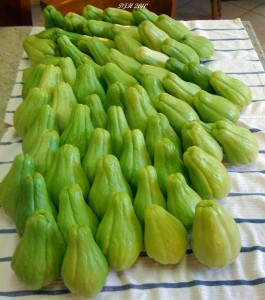
65 Mirlitons Harvested from a single plant.
We were in disbelief. I had read how these vines can produce between 50-100 and here we were within that range. In addition, there were still another dozen or so smaller ones we left to continue growing until a freeze came. After we brought them in and cleaned them up, we set them on the counter. Now we had an even bigger dilemma. How were we going to possibly cook so many?
Anyway, it has been close 10 years since that first successful harvest. I am happy to report that I was able to start some seed mirlitons in pots the following January and in the Fall of 2011 had my first fruitful harvest of mirliton in my yard in Mobile. I planted three of these Louisiana Heirloom Mirliton in my yard and today one of these is still alive and thriving. Since that time, I am happy to report that I have been fortunate enough to get in contact with Dr. Hill and we have established that the variety I have been growing were similar to some he had studied but didn’t quite match any of them exactly. From our initial correspondence and subsequent conversation, he indicated I could name it mine as I saw fit, so in honor of my Pepere’s friend whom I received the initial seed mirliton I have named it the Boudreaux-Robert mirliton (the origins on where Mr. Boudreaux got it will have to be told in another post). Since 2010, I have tried over a dozen different mirliton recipes, shared close to 25 mirliton seedlings with family and friends, and created lots of great memories sharing the story of the miriton with folks here in south Alabama. Growing mirliton represent more to me than just growing something to eat. Doing so helps to keep me connected to my Father and Pepere, who have both passed since I started this adventure in 2006, my Louisiana heritage as well as learning, sharing, and helping preserve one of south Louisiana and the Gulf Coast’s most iconic and endangered vegetables.
H
by Lance Hill | Apr 21, 2012 | Mirliton
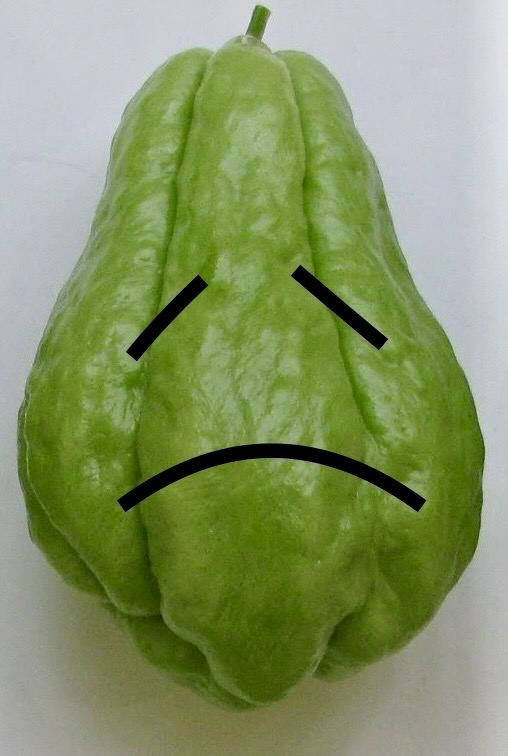
Mirlitons (Sechium edule) in the United States south have two main fruiting seasons that begin after the spring and fall equinox, which generally means flowering begins in May for several weeks and again in October until December. The plant initiates flowering in response to leaf signals when leaves detect equal periods of light and darkness (photoperiodism). This stimulus is combined with temperature changes (thermoperiodism) in the fall: a cold snap after the equinox can help stimulate flowering. Spring crops are normally much smaller than the fall crop.
This early crop has created an opportunity to use the winter/spring fruit for seed. But these cool-weather mirlitons can be a little cranky if panted in hot weather.
Spring fruit can be used as seed but must be planted using special methods. The goal is to get the sprouts into the ground as soon as possible so they can develop a root structure sufficient to meet the water needs of the top growth when temperatures reach 90 °F as early as May. Unlike containerized plants or seeds that were planted the previous fall, these sprouts begin the summer with no root structure.
Spring fruit should be allowed to mature for at least three weeks on the vine and meet the “thumbnail test”: press your thumbnail into the skin and if the fruit flesh is soft and the nail leaves a dent, then the fruit is not ready to pick. Also if you are familiar with the heirloom variety that you are growing, you will know the average size of a mature fruit. The fruit must be mature to be able to germinate and sprout.
Hot Weather Planting of Sprouts:
During normal growing cycles, the fruit may not be ready to pick until late May and won’t sprout until June or later. Temperatures over 90°F. can suppress shoot and root development and dehydrate the seed fruit that is exposed to the sun. I’ve done that in the past–planted a sprout in June and watched it sit there and do nothing. When I excavated it, I saw how distressed the seed had become by the scorching sun. Instead of coming up, the shoot stayed below ground and wound in a circle.
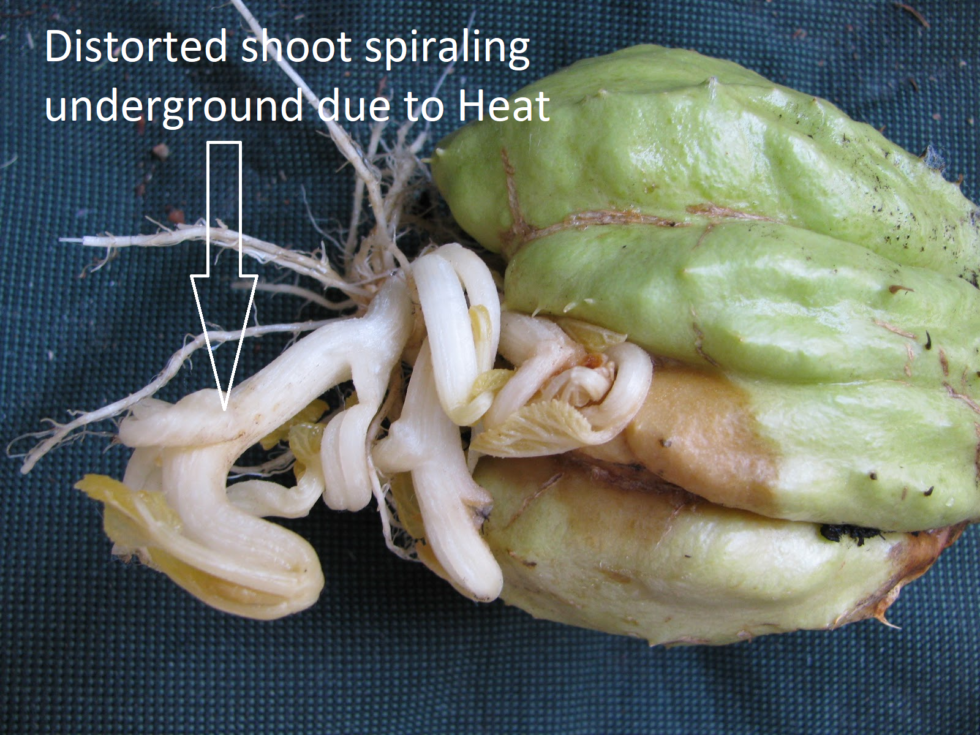
So sprout-planting in May and June should be done as you normally would, but place a milk crate over the planted sprout and cover it with shade cloth. This will protect it from the intense solar heat. The milk crate will also protect the mirlitons from squirrels and other rodents that like tender young fruit.
Once the shoot begins to grow, you can remove the crate and stake the vine.

 Lapeyrolerie Mirlitons
Lapeyrolerie Mirlitons


 Lapeyrolerie Mirlitons
Lapeyrolerie Mirlitons




 David Hubbell with his Boudreaux-Robert heirloom mirliton variety.
David Hubbell with his Boudreaux-Robert heirloom mirliton variety.



Recent Comments